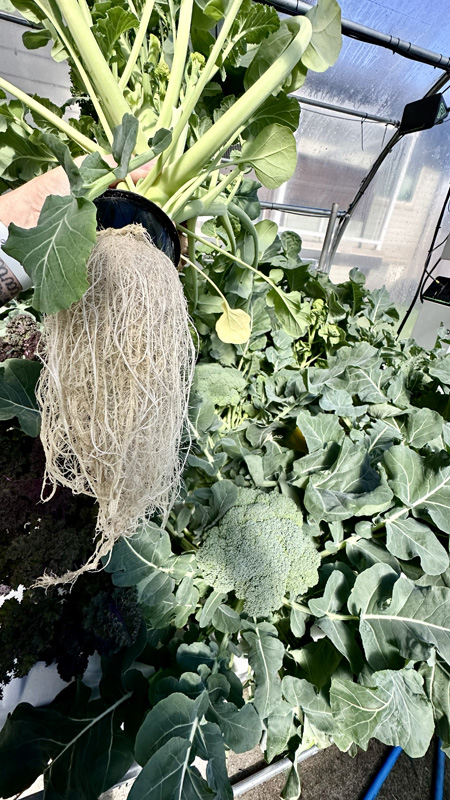Growing Aeroponic Vegetables, Part II

Cultivating Aeroponic Food Crops
In Part I of our series on growing aeroponic vegetables, we explored the operating principles and benefits of high-pressure aeroponics systems. We also covered how to propagate crops for medium-less production using our aeroponic setup.
In Part II, we pick up where we left off and share our experience and findings on growing and harvesting cold-weather crops successfully using aeroponics. We’ll also transition into our results with warm-season crops grown in a smart greenhouse setting.
We were especially impressed by the kale and broccoli we harvested—particularly the broccoli! While kale is generally a hardy and easy crop to grow, the Red Bor and Green Bor cultivars exceeded expectations. These plants thrived, delivering exceptional flavor and texture. There was no “green” or harsh aftertaste—just incredible sweetness and crispness. In fact, the taste surpassed any kale we’ve sampled across organic, hydroponic, and other methods. The leaves were dense, and the plants grew squat and full.
Historically, we’ve struggled to produce broccoli florets during the cold season in the Pacific Northwest. We’d had some success with greens but never significant floret production—until now.
Thanks to the addition of an efficient supplemental lighting system (SUNaaS) and the ability to program and control our Daily Light Integral (DLI), our winter broccoli produced a very impressive harvest of florets.
Our aeroponic system supported outstanding crop health and rapid growth. The bare roots remained resilient even during cold spells when root zone temperatures dropped to 2°C during peak dark hours in the greenhouse. To offset heating costs, we used a low-wattage aquarium heater in the reservoir, allowing us to warm the root zone without needing to heat the entire greenhouse with high-wattage devices.
The broccoli crowns we harvested were about the size of dinner plates—dense, flavorful, and unbeatable in quality. In addition to primary crowns, the plants also produced abundant side crowns. The large, fast-growing foliage—especially in high-density planting—necessitated regular trimming. These harvests of nutrient-rich broccoli greens added to our cold-season yields while helping manage plant space.
Tips for Cold-Weather Growing Aeroponic Vegetables
- If maintaining cooler air temperatures to conserve power, use aquarium heaters in the aeroponic reservoir to keep roots in a more optimal range during misting cycles (roots will cool between mists).
- Increase misting frequency with temperature-controlled nutrient solution if greenhouse air remains cold. For cold-weather crops, do not exceed 15°C in the reservoir.
- Use an EC of 2.4–3.2 in the aeroponic reservoir during crop maturation, using Cultured Solutions Bloom A&B liquid hydroponic fertilizer. During early vegetative stages post-transplant, we maintained an EC between 1.5 and 2.4.
- Topping up with fresh water, nutrients, and adjusting pH is easy to automate—especially with our smart doser system. We allow some range drift rather than locking in specific values.
Our high-pressure aeroponics system from Current Culture H2O performed beyond expectations for growing aeroponic vegetables in cold climates. We’re genuinely excited for the next winter season to grow even more delicious broccoli and kale—nothing else compares in taste!
Aeroponic System Maintenance and Cleaning
During our cold-weather run, the aeroponic system required virtually no maintenance. We occasionally observed the misting cycles and found no clogs or reduction in mist output.
At terminal harvest, we removed plants with roots intact. Any residual root matter was minimal and easily cleared, requiring very little cleanup. The lack of grow medium kept the greenhouse area neat and easy to maintain.
A quick wipe-down using a sponge with fresh water and a mild bleach solution left the high-pressure aeroponic (HPA) modules and lids looking like new. This saved time and avoided soaking the greenhouse during cold weather. We also sanitized the delivery lines by running a hypochlorous acid solution (Clear Line), then refilled the reservoir with fresh water—ready to plant again.
Growing Aeroponic Vegetables: Warm-Season Greenhouse Crops
Our smart greenhouse had minimal downtime between crop cycles. We had already propagated new aeroponic plugs for the warm season, including tomatoes, hot peppers, basil, cucumbers, squash, pumpkins, and melons.
Several tomato cultivars were used in a lighting experiment during early vegetative growth to evaluate lighting treatments on both shoot and root development. One of the key advantages of our HPA system is the ability to easily inspect root systems, which is especially useful for plant studies.
In the next installment of growing aeroponic vegetables, we’ll share results from warm-season crops, including high-value herbs like Genovese basil and full-term crops such as heirloom tomatoes.
Until then, stay tuned! Visit our website for more updates and check out our ongoing projects on Instagram under “Hydroponics in the News.”
The post Growing Aeroponic Vegetables, Part II appeared first on GROZINE.







